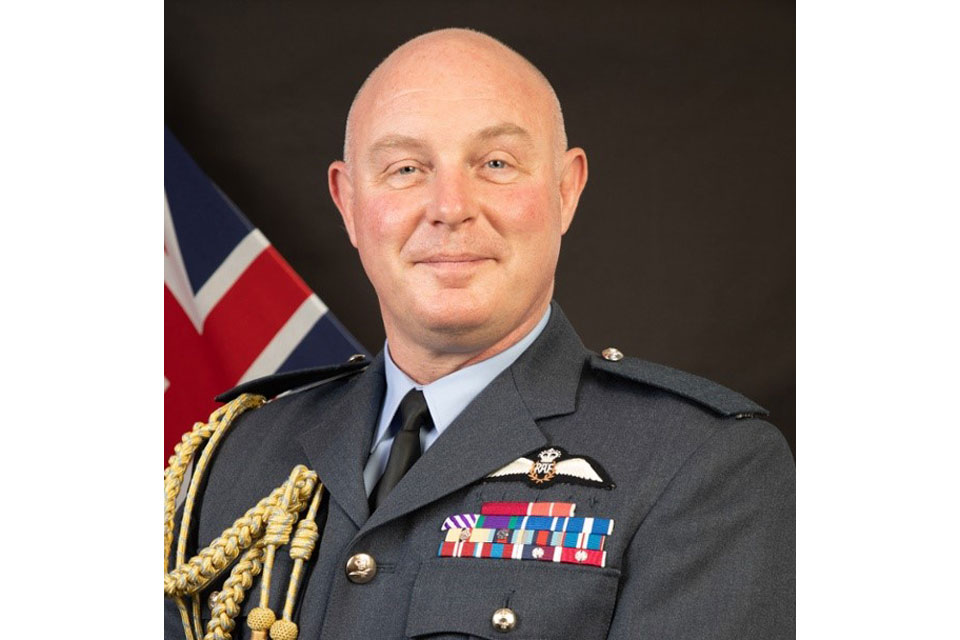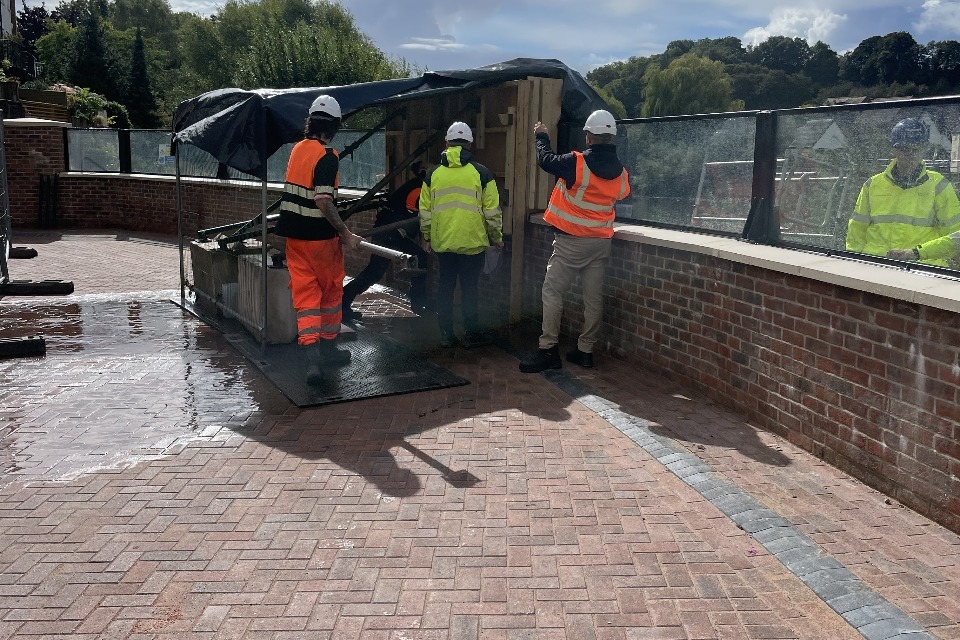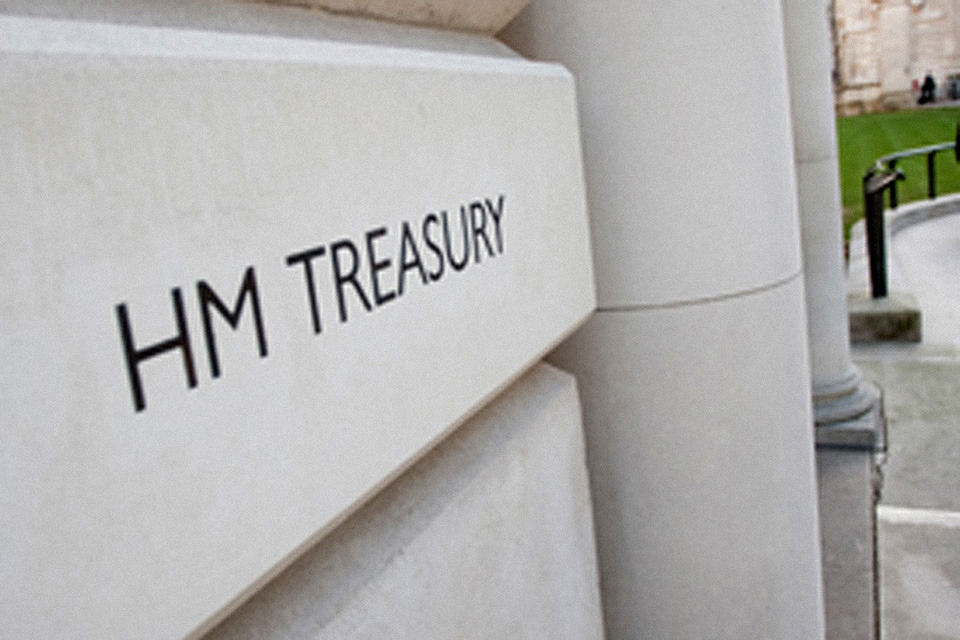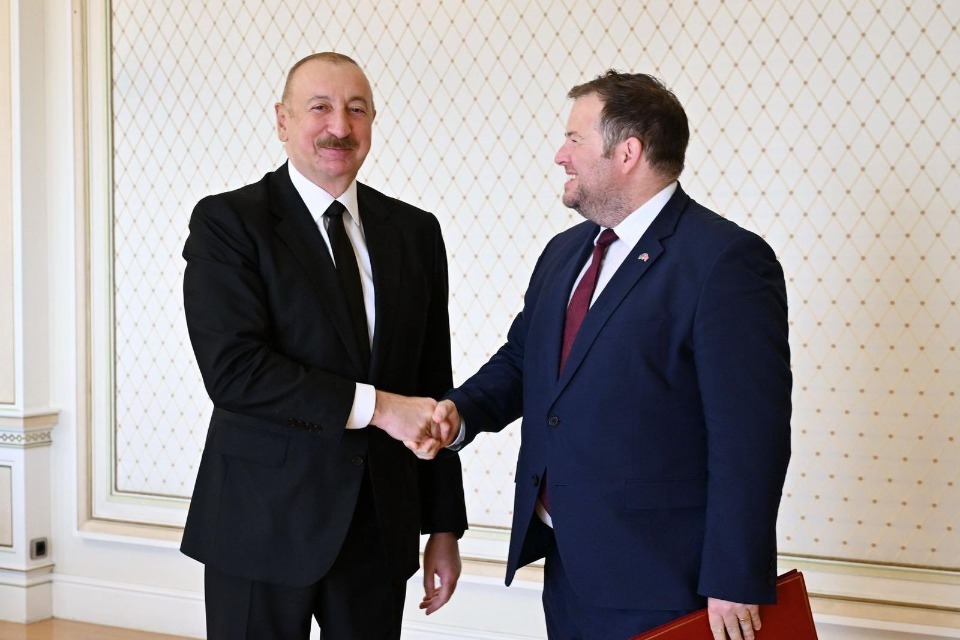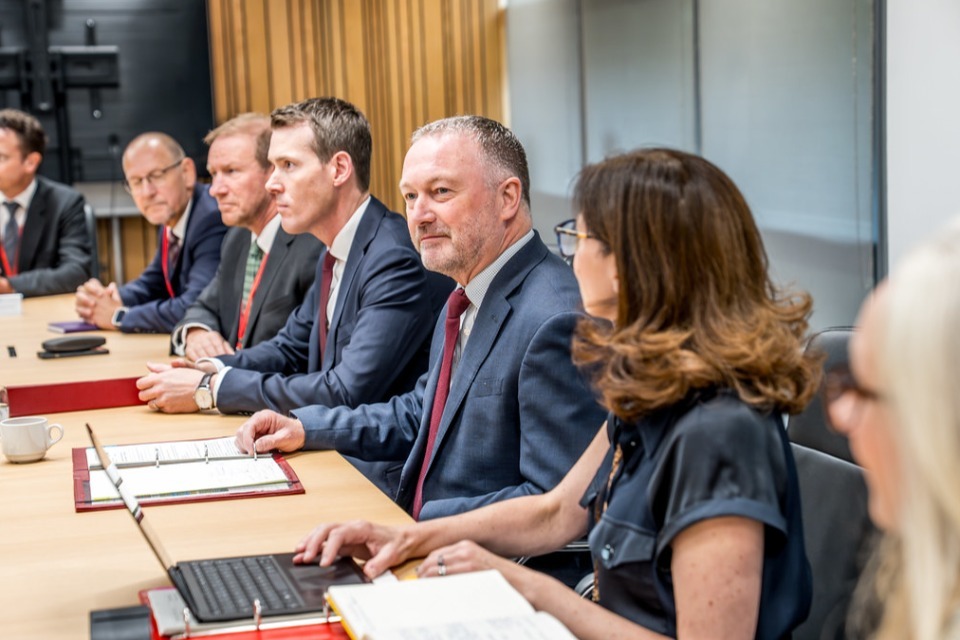Ladies and Gentlemen, I am honoured to take to the stage here once again at DSEI, and to deliver my first keynote speech as the Chief of the Air Staff. And I would like to start by taking this opportunity to thank my predecessor and our new CDS for everything he did during his tenure to set a strong operational foundation from which I now have the opportunity to spring board forward.
To the Clarion team, thank you for the very kind invite and for the opportunity to speak, and indeed, to DJ at the DSEI Silent Disco… I’ll be taking requests during the break!
I think I last stood here in 2021 as the MOD’s inaugural Director Space, and spoke about the importance of the Space domain – at that time I was on a quest to stand up UK Space Command, and build a new Defence Space Strategy and programme. I’ll come back to Space a little later, but would highlight how far we have come in that short 4 year period in terms of our approach to the Space Domain, and it is heartening news that Space Command has just recently declared IOC with its first LEO-based ISR satellite – the beginning of what will now build towards the UK’s independent ISTARI constellation, which in time will underpin the new CSOC’s approach to intelligence collection, and our innovative digital targeting web … the backbone of what our recent SDR references as the Integrated Force.
A lot has changed since 2021 COVID and the following post-pandemic cost of living crisis, new ways of working, the West’s withdrawal from Afghanistan, a decline in democratic governance across the world, a new British monarch, a new Labour Government, a new Trump Administration, an enduring and bloody war in Europe, the return of great power competition, Finland and Sweden joining NATO, Hamas’ brutal attacks into Israel, and Israel’s response, the fall of Syria’s Asad, air operations against the Houthis, the AI Boom, US strikes against Iran’s nuclear sites … and so it goes on.
This pace of change and challenge is phenomenal, and the old adage of ‘never say never’ has been completely validated –cutting to the chase … my prime focus as the new CAS is to meet this pace of change head on … by putting more AIR into Air … more agile, more integrated, more ready, to fly and fight, today, tomorrow and together.
This all said, much of the last 4 years also has a broad sense of familiarity – constant yet unpredictable turmoil in the Middle East, the battle for talent, a confrontational Russia, and a high demand on our military forces – all recognised as part of the analysis that underpinned our recent SDR.
The breadth and depth of the challenge shows no signs of abating … a volatile world … an era of radical uncertainty, and the most perilous period in the whole of my 35-year military career.
Until recently, we have enjoyed the peace dividend, born out of a Cold War victory and a 30-year focus on counterinsurgency operations, fighting far from home, sanctuary here in the home base, allowing a relentless focus towards garrison efficiency, no existential threat to our nation, and broadly manageable impact on the national purse.
Today, it is different – we face multiple and multiplying threats, war in Europe, a status quo reset in the Middle East, and the growing US focus on homeland defence and the Indo-Pacific.
And the challenges are not contained regionally. North Korean troops are fighting just a 3-hour flight from where we are today. New alliances are forming. Russia, China, Iran, and North Korea are all active in today’s battlespace, across all domains, especially the newer ones of Space and Cyber – learning, adapting, and collaborating … we should take note of the scenes of Ji, Putin, KJU and Pezeshkian, together in Beijing last week … all watching, whilst China displayed its military might via a vast parade of goose stepping soldiers and new weapons, including the Guam killer missile, loyal wingmen dones, and even robotic wolves.
A clear message to the world – and also undoubtedly a sales pitch for new weapons, presenting a proliferation challenge which we must not ignore.
Great power competition is back, and as the Prime Minister said recently
‘We must recognise the new era we are in, not cling hopelessly to the comforts of the past.’
Hence our government is investing in Defence, with a new Strategic Defence Review and the much welcomed announcement at the Hague NATO Summit on increased spending; an overt recognition of a more contested world, and a profound statement of intent to be more secure at home, and strong abroad.
The peace dividend is under threat – and for the first time in my career, we enter the era of the defence dividend, with a Chancellor whose stated ambition is to make the UK a “defence industrial superpower”.
So yes … the world has changed; and this change demands that we think about the new threats we will face, some sooner than expected, how we will deter them and, if necessary, fight and win, both today and tomorrow.
And of course, integral to this effort are the air & space domains both, essential components of our aspiration to have a truly integrated force consistently in high demand, critical to any coalition’s ability to understand the battlespace, to move and operate with agility, pace and scale, and central to NATO’s way of warfighting, our most precious alliance and the bedrock of our approach to national security over the last 76 years … and arguably, looking forward, the next 76 will be even more important.
In an uncertain future, air and space power will continue to be Defence’s first responder, the nation’s first line of defence, and the integrated force’s quickest means to strike, with the precision, agility, speed, and reach to deliver effect globally, offering wide political choice, generally with lowest risk.
As part of its preparation for the recent Strategic Defence Review, the RAF Strategy laid out our rationale on a desired future direction. It was an excellent piece of work as evidenced by the fact that the SDR is underpinned by the clarity, relevance, and logic of the air and space power argument.
As a new CAS stepping into the chair, the SDR has been very clear in how I must prioritise our efforts, starting with a NATO First approach, alongside a renewed focus towards homeland defence and resilience, whilst in parallel working closely with the other Services to meaningfully build a digitally enabled, Integrated Force.
Learning from current conflicts, we will build a stronger, closer partnership with Industry, and invest in cutting-edge technologies, accelerating and honing our combat edge to stay ahead of our adversaries with a combination of next generation digital and conventional capabilities; accelerating the integration of Space-based assets, uncrewed systems, AI, and autonomy, to complement our already fielded stable of exceptional warfighting capabilities.
As a constant, our focus must remain on our people, our infrastructure, and our enablers … we cannot be seduced away from these 3 foundational areas by new, shiny equipment programmes – building readiness and resilience in these areas is fundamental to our ability to fly and fight.
This said, we must in parallel be clear on our operational priorities, which centre on deterrence and control of the air and space, from a revamped approach to fighter pilot training, to the meaningful introduction of collaborative combat aircraft, to a future where GCAP is the cornerstone of our Fast Jet capability
In the detail of all of this, there are 3 specific areas I would mention today, because these are where I intend to overtly increase RAF focus and pace in the near term the reintroduction of an RAF nuclear capability; Integrated Air and Missile Defence; and our approach to Space.
At the dawn of the first nuclear age in the early 1950s, Chief of the Air Staff Sir ‘Jack’ Slessor, wrestled with problems similar to those we face today, in terms of balancing the need to optimise for the fight tonight, versus modernising for the fight tomorrow – he summarised this as
Getting the balance right between being ready too soon with weapons that may be of little use when war comes, and being ready too late in our attempt to achieve the perfect weapon.
As a bit of an aside, like me, Slessor also commanded Number 4 Squadron, with the motto In Futurum Videre (in foo-tu-room, wi-deh-reh) meaning ‘to see into the future.’
Neither of us knew that years after commanding Happy 4, the unit’s motto would be the challenge that would face us both at the pinnacle of our RAF careers.
On nuclear, which Slessor referred to as the Great Deterrent, he intimately understood our need to have a robust graduated response capability, tailored to fit the dynamic strategic environment. He accurately assessed that
‘There must be something between the hydrogen bomb and the frontier policeman.’
The Royal Navy’s Continuous at Sea Deterrent has provided the ultimate guarantee of our security since the late Sixties and will continue to do so into the future with the ongoing Dreadnought programme.
However, we need to recognise the void identified by Slessor, between CASD and our conventional capabilities.
Against this backdrop, the Government’s announcement at the recent NATO Summit, whereby the RAF will once again return to the sub-strategic nuclear game, by procuring F35A and joining NATO’S DCA partnership, is much welcomed. A nuclear-capable Lightning presents the UK with a mechanism to provide considerable support to our ‘NATO First’ approach and NATO’s nuclear mission.
The RAF will soon have the opportunity to offer NATO additional robust, credible, and capable response options, because we’ve added this important rung to our escalation ladder one that has been missing from the UK’s political, diplomatic, and military toolset for nearly three decades. I would expect potential adversaries to take note of this change.
Of course, there are multiple challenges to address in delivering this capability, not least the fact that there are very few individuals currently serving in the RAF who have experience of the nuclear enterprise. To reinforce a phrase often used by the previous CDS, we must build our nuclear IQ, and quickly. This will be a core effort during my tenure as CAS, spurred on by the fact that multiple NATO nations with a fielded DCA capability have already offered me the most intimate of support, to deliver this capability at pace, and with precision. A superb example of the power of trusting partnerships.
Shifting to Integrated Air & Missile Defence, or IAMD, this month, we rightly and proudly commemorate the 85th anniversary of our Service’s ‘Finest Hour’ – The Battle of Britain. 9 decades ago, Dowding created the first approach to IAMD – The Dowding System – relatively small, but highly efficient, battle winning and subsequently replicated globally.
Today, as it was in the skies above us in the summer of 1940, Control of the Air is critical. This is our Air Force’s core role; not only does it enable air and space power, but it also enables the other domains, and the integrated force. More importantly, it underpins our commitments to NATO’s Article 3.
Ukraine is a stark reminder of what warfare becomes when neither side can gain effective control of the air stalemate, trench warfare, and millions of lives lost.
Any IAMD solution will be multi-domain. Rather like the Dowding System that involved land, sea and air, today our response will also encompass space and cyber.
IAMD is more than just ground-based air defence, it is a multi-domain, multinational layered capability with command & control, sense and warn, missile defence systems, defensive combat air, and, importantly, a range of offensive capabilities, as critical components.
Colloquially, when discussing IAMD there is much talk about shooting the archer, not the arrow. But in reality, we will need to also interdict the fletcher, the bowyer and the armourer to ensure that the archer never has the tools to do their job.
IAMD will also need to be multi-national – integrated with allies, and especially across NATO.
In the near-term, our focus will be on integrating what we already have – optimising current capabilities for best possible effect – this will rely directly on ensuring we remain at the top of our game in delivering integrated Command and Control.
Beyond C2, we will improve our sense and warn capabilities, both on the ground and in the air – and of course, our new E7 Wedgetail air system, flown at this summer’s RIAT for the first time, will be vital to this, providing a core element of a broader system of updated ground-based radars and space capabilities, as part of an agile, integrated, and distributed sense and warn system.
The SDR’s announcement of up to £1bn of new funding for homeland air and missile defence is most welcome, and will allow us to begin the journey of delivering a modern and capable IAMD system. And, under our new Defence Reform model, I look forward to acting as Lead Command for this effort, working alongside others in Defence, Industry, and our allies, to deliver an outcome fit for purpose against the expected threats we face, today and tomorrow.
And thirdly, to Space … this domain matters now more than at any other time in our lifetimes. Its relevance and importance have never been more evident, underpinning the foundation of modern life.
Once a domain focussed primarily on daring space exploration, it is now an arena of strategic, economic, and political rivalry and competition. It is vehemently contested and overly congested.
In the next decade, the global space economy is forecast to reach £1.8 trillion.
Today, nearly 20 per cent, or £450 billion, of the UK’s economy is underpinned by Space-based services, and the UK Space sector alone generates about £17 billion in growth.
It is clear that we are increasingly reliant on space. For example, the loss of the GPS timing signal alone would cost the UK economy about £1 billion a day – this is a worse impact than experienced at the height of COVID.
All this, against a backdrop where our opponents are investing heavily in Space and are outpacing us.
The SDR dedicates a chapter to this topic, and rightly elevates space to parity alongside the traditional warfighting domains.
It also recognises that we need to build a modern, agile, resilient defence and civil space infrastructure…one capable of meeting the threats, mitigating the risks, seizing the opportunities, and preparing for the challenges of today and tomorrow.
At the recent Global Air and Space Chiefs’ Conference, one of our senior space partners said that if you have zero capability in space, you have zero capability in every other domain. I agree. Space underpins deterrence in all domains, and is the keystone to our ambition of delivering an Integrated Force.
To build such Space capability, the SDR calls for a more ambitious approach to assuring access to space, both on a sovereign basis, with NATO, and other key allies. Consequently, our investment priority areas are Space Control and Decision Advantage, as well as Sense, to enable ‘Understand’ and ‘Strike’ functions.
These principles are neither new nor contentious, but are critical – our ability to control the space domain at a time and a place of our choosing, benefits everyone within the Integrated Force, not just those within the space domain.
Even at this early stage in my CAS tenure, I can see the need for a UK Space Defence Centre, to enable clear command and control of our assets, accompanied by credible counterspace capabilities to protect and defend our vital national interests in space.
And we are not going to do this alone – having been Director Space, I have witnessed firsthand that this is the ultimate team sport. By working with our allies and partners, we can turn the theory into a reality – just as Dowding did in the late Thirties, preparing us for the Battle of Britain.
We are currently presented with the exciting opportunity to make a tangible and critical difference in the Space domain. It must happen this decade, and as Lead Command for Space, I will ensure the RAF champions this approach. And, just like we must ramp up our Nuclear IQ, we must do the same regards our understanding of the Space Domain … Space matters to defence, our nation, and our allies. Again, this will be a core effort during my tenure as CAS, and I look forward to engaging with the breadth of the space enterprise, in UK and internationally, to understand how best to increase our pace in this area, to ensure the right capabilities are delivered for today’s fight, and the right foundations are set to be best placed for tomorrow.
To conclude, our potential adversaries are not standing still – in fact, they are approaching a sprint – their military industrial complex is in full swing, and it oftentimes feels like ours is still in peace mode – therefore, there is much work to be done, and we cannot afford to squander the time we have.
This said, I am supremely confident that he we have the right people in our whole force team, with the professionalism, ingenuity, resilience, drive and fighting spirit to make the change, and make the difference.
And, of course, the Defence Industrial Strategy announced just this week, reinforces our backing of UK industry, and will put the UK at the leading edge of defence innovation, to revolutionise not just our defensive capabilities, but our entire economic landscape.
The RAF remains the nation’s first responder; we have a proud legacy; but must never be distracted or complacent.
We must relentlessly pursue the excellence demanded by our leaders, our nation, and our allies. As Churchill asked for
‘Successful deterrence operated from sober, calm, and tireless vigilance.’
Going forward, I intend to put more AIR in Air
More Agile, more Integrated and more Ready, to fly and fight – today, tomorrow, and together.
Returning to Slessor, for the final, salient word
‘Our swords must be in our hands. It is no good thinking that we can forge them, or draw them from the armoury, after the emergency is upon us.’
Thank you.


